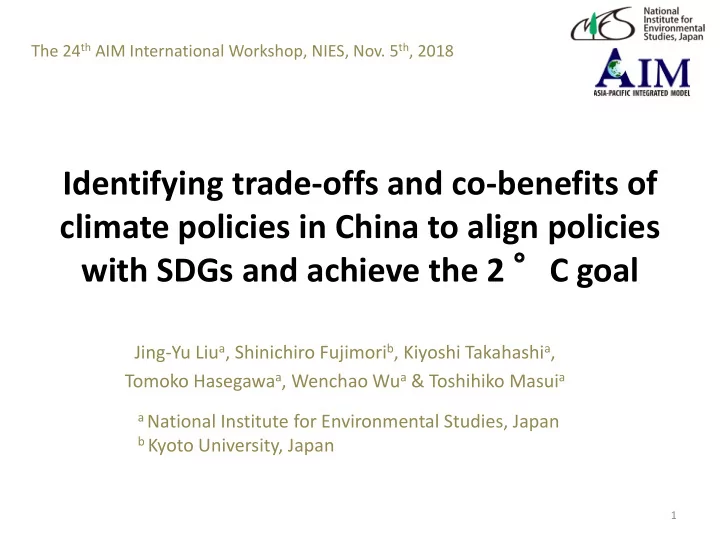

The 24 th AIM International Workshop, NIES, Nov. 5 th , 2018 Identifying trade-offs and co-benefits of climate policies in China to align policies with SDGs and achieve the 2 ° C goal Jing-Yu Liu a , Shinichiro Fujimori b , Kiyoshi Takahashi a , Tomoko Hasegawa a , Wenchao Wu a & Toshihiko Masui a a National Institute for Environmental Studies, Japan b Kyoto University, Japan 1
Outlines • Introduction • Methodology • Results • Conclusions 2
Introduction • Paris Agreement and UN 17 SDGs in 2015 • Climate policies have side-effects on SDGs related indicators. – Energy, air quality, food, land and so on • Country-level analysis: China level analysis: China • Scope: – SDG 7 energy security – SDG 3.9 health through air quality – SDG 2 hunger – SDG 15.2 forest management 3
Research questions • What are the trade-offs and co-benefits associated with climate change mitigation policies with respect to the SDGs spaces ? • Are there possible ways to implement a sustainable climate policy instruments that will not cause trade-off relationship but in line with the 2 ° C goal? 4
Outlines • Introduction • Methodology • Results • Conclusions 5
Investigated indicators SDGs Indicator Calculation Standardization Primary energy diversity Energy security indicator, Shannon index Energy security Primary energy imports Negative value: Air quality SO2 emissions per year co-benefits Air quality NOx emissions per year Air quality BC emissions per year Non-Energy Crops and Positive value: Food security Livestock aggregated price trade-offs Food security People at risk of hunger Food security Import per consumption Forest management Forest area 6
Scenario Scenarios and descriptions categories baseline No carbon prices Model: AIM/CGE Simple policy 2Deg(INDC): reflects the tendency of current policy scenarios in China before 2030 but meets 2 °s at the end of this century 2Deg(EarlyAct): follow least cost mitigation scenario. Comprehensive 2Deg(EarlyAct)+Combine: 300% forest subsidy and policy scenarios 67% food subsidy was assumed on the basis of 2Deg(EarlyAct) scenario. Sensitivity See below scenarios Sensitivity scenarios Scenario name Description GDP_High SSP1 assumption. Higher GDP. GDP_Low SSP3 assumption. Lower GDP. POP_High SSP3 assumption. Higher population. POP_Low SSP1 assumption. Lower population. Trs_High SSP3 assumption. Higher transportation demand. Figure Emissions trajectories Trs_Low SSP1 assumption. Lower transportation demand. Yield_High SSP1 assumption. Higher yield. Yield_Low SSP3 assumption. Lower yield. NoCCS CCS not available. NoBECCS BECCS not available. 7
Outlines • Introduction • Methodology • Results • Conclusions 8
Scenarios Figure Emissions trajectories for simple climate policy scenarios 9
Positive and negative side effects of climate policy Figure risk of sustainability in reference to Baseline ➢ Energy security and air quality have co-benefits, which would back climate policies. ➢ Deforestation risk changes the most from BaU therefore would be the major source of criticisms and concerns for climate policies. 2Deg(EarlyAct) is with less deforestation than 2Deg(INDC) in 2050. ➢ Food security raise some concerns too. 10
Scenarios Scenario Scenarios and descriptions categories Baseline No carbon prices Simple policy 2Deg(INDC): reflects the tendency of current policy scenarios in China before 2030 but meets 2 °s at the end of this century Comprehensive 2Deg(EarlyAct)+Combine: 300% forest subsidy and policy scenarios 67% food subsidy was assumed on the basis of 2Deg(EarlyAct) scenario. 11
Necessity of complementary policy package ➢ All of the indicators are achieved zero-trade-off in 2050 comparing Risk ++ Risk ++ with Baseline in 2Deg(EarlyAct)+Combine. • Early climate action • Forest protection policy • Food subsidy policy 12
Sensitivity Scenarios Scenario name Description GDP_High SSP1 assumption. Higher GDP. GDP_Low SSP3 assumption. Lower GDP. POP_High SSP3 assumption. Higher population. POP_Low SSP1 assumption. Lower population. Trs_High SSP3 assumption. Higher transportation demand. Trs_Low SSP1 assumption. Lower transportation demand. Yield_High SSP1 assumption. Higher yield. Yield_Low SSP3 assumption. Lower yield. NoCCS CCS not available. NoBECCS BECCS not available. 13
Sensitivity analysis ➢ The sustainable pathway 2Deg(EarlyAct)+Combine is robust regarding energy security, deforestation and air quality. ➢ Food security indicators are largely affected by social economic condition rather than the climate policies. ➢ CCS technology needs special attention. 14
Outlines • Introduction • Methodology • Results • Conclusions 15
Conclusions • Energy security and air pollution can have a great benefit from the climate mitigation measure while food security and land can have a negative side effects. • To resolve this trade-off relationship, early climate action is preferable. • Subsidy mechanism in food goods and land rent successfully diminished the negative side effects keeping other area’s co - benefit aligning with climate targets. • Subsidy mechanism is just an illustrative example of a complementary policy package. 16
Thank you! 17
Backup slides 18
19
20
21
22
23
Tabl able SI. SI.1 1 Ad Addit itional scenario io de desi signs Sce Scenario io categor ories Res Research pur purpose ses Scenario ios and de descrip iptions Single complementary Assess the negative 2Deg(EarlyAct)+Forest: policy scenarios side-effects on only 300% forest subsidy SDGs of policy was assumed on the basis scenarios where of 2Deg(EarlyAct) single scenario. complementary 2Deg(EarlyAct)+Food: policy is added. only 10% food subsidy was assumed on the basis of 2Deg(EarlyAct) scenario. 24
25
26
Recommend
More recommend